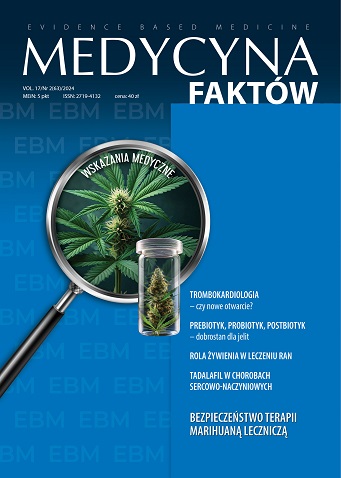Tropocollagen injections as a key element of comprehensive treatment of sports injuries Case report
Main Article Content
Abstract
Standard methods of treating sports injuries, such as restrictions on physical activity, pharmacotherapy, physiotherapy and surgery, consume patients? time. That is why we are looking for other treatment methods that do not omit the necessary natural healing cycles but only accelerate their phases. Due to their potential benefits in accelerating regenerative processes, tropocollagen injection therapies are becoming an increasingly popular method that is an important part of comprehensive sports injury therapy. Tropocollagen, a precursor of collagen, plays a key role in the regeneration of connective tissue. The aim of this article is to present the mechanisms of action of tropocollagen and to assess its effectiveness as an important complementary therapy in the optimal treatment of sports injuries in selected clinical cases. Two cases of the use of tropocollagen were presented: in a 25-year-old patient practicing sprint running who suffered a quadriceps muscle tear, and in a 32-year-old patient practicing long-distance running as an amateur who experienced recurrent back pain during running. In both cases, tropocollagen injections were used to modify the therapy, achieving the desired therapeutic effect.
Article Details
Copyright © by Medical Education. All rights reserved.
References
2. Prieto-González P, Martínez-Castillo JL, Fernández-Galván LM et al. Epidemiology of Sports-Related Injuries and Associated Risk Factors in Adolescent Athletes: An Injury Surveillance. Int J Environ Res Public Health. 2021; 18: 4857. http://doi.org/10.3390/ijerph18094857.
3. Pavan PG, Stecco A, Stern R et al. Painful Connections: Densification Versus Fibrosis of Fascia. Curr Pain Headache Rep. 2014; 18: 441. http://doi.org/10.1007/s11916-014-0441-4.
4. Wilke J, Hespanhol L, Behrens M. Is It All About the Fascia? A Systematic Review and Meta-Analysis of the Prevalence of Extramuscular Connective Tissue Lesions in Muscle Strain Injury. Orthop J Sports Med. 2019; 7: 232596711988850. http://doi.org/10.1177/2325967119888500.
5. Angly B, Constantinescu MA, Kreutziger J et al. Early versus Delayed Surgical Treatment in Open Hand Injuries: A Paradigm Revisited. World J Surg. 2012; 36: 826-9. http://doi.org/10.1007/s00268-012-1455-x.
6. Handoll HH, Elliott J, Thillemann TM et al. Interventions for Treating Proximal Humeral Fractures in Adults. Cochrane Database Syst Rev. 2022; 2022: http://doi.org/10.1002/14651858.CD000434.pub5.
7. Ueblacker P, Haensel L, Mueller-Wohlfahrt HW. Treatment of Muscle Injuries in Football. J. Sports Sci. 2016; 34: 2329-37. http://doi.org/10.1080/02640414.2016.1252849.
8. Stephenson SD, Kocan JW, Vinod AV et al. A Comprehensive Summary of Systematic Reviews on Sports Injury Prevention Strategies. Orthop J Sports Med. 2021; 9: 232596712110357. http://doi.org/10.1177/23259671211035776.
9. Bell JS, Hayes S, Whitford C et al. Tropocollagen Springs Allow Collagen Fibrils to Stretch Elastically. Acta Biomater. 2022; 142: 185-93. http://doi.org/10.1016/j.actbio.2022.01.041.
10. Biryukov SY. On the Use of Type I Tropocollagen for Local Injection Therapy of Spine, Upper and Lower Extremity Disorders. Ter Arkh. 2023; 95: 1197-204. http://doi.org/10.26442/00403660.2023.12.202533.
11. Asgari M, Latifi N, Heris HK et al. In Vitro Fibrillogenesis of Tropocollagen Type III in Collagen Type I Affects Its Relative Fibrillar Topology and Mechanics. Sci Rep. 2017; 7: 1392. http://doi.org/10.1038/s41598-017-01476-y.
12. Goldberg B, Sherr CJ. Secretion and Extracellular Processing of Procollagen by Cultured Human Fibroblasts. Proc Natl Am Acad Sci. 1973; 70: 361-5. http://doi.org/10.1073/pnas.70.2.361.
13. Mariggi? MA, Cassano A, Vinella A et al. Enhancement of Fibroblast Proliferation, Collagen Biosynthesis and Production of Growth Factors as a Result of Combining Sodium Hyaluronate and Aminoacids. Int J Immunopathol Pharmacol. 2009; 22: 485-92. http://doi.org/10.1177/039463200902200225.
14. Duffy AM, Bouchier-Hayes DJ, Harmey JH. Vascular Endothelial Growth Factor (VEGF) and Its Role in Non-Endothelial Cells: Autocrine Signalling by VEGF. In Madame Curie Bioscience Database [Internet]; Landes Bioscience, 2013.
15. Mościcka P, Cwajda-Białasik J, Szewczyk MT et al. Healing Process, Pain, and Health-Related Quality of Life in Patients with Venous Leg Ulcers Treated with Fish Collagen Gel: A 12-Week Randomized Single-Center Study. Int J Environ Res Public Health. 2022; 19: 7108. http://doi.org/10.3390/ijerph19127108.
16. Kviatkovsky SA, Hickner RC, Cabre HE et al. Collagen Peptides Supplementation Improves Function, Pain, and Physical and Mental Outcomes in Active Adults. J Int Soc Sports Nutr. 2023; 20: 2243252. http://doi.org/10.1080/15502783.2023.2243252.
17. Massullo C. Injectable Guna Collagen Medical Devices in Functional Recovery from Sport Traumatology ? Guna Collagen Medical Devices. Physiol Regul Med. 2017; 3-7.
18. Corrado B, Bonini I, Tarantino D et al. Ultrasound-Guided Collagen Injections for Treatment of Plantar Fasciopathy in Runners: A Pilot Study and Case Series. J Hum Sport Exerc. 2020; 15: S793-805. http://doi.org/10.14198/jhse.2020.15.Proc3.30.
19. Milani L. A New and Refined Treatment for Musculo-Skeletal Disorders Bioscaffold Properties of Collagen and Its Clinical Use. Physiol Regul Med. 2010; 1: 3-15.
20. Ottaviani M. Treatment of Joint Conditions with Guna Collagen Medical Devices ? Clinical Study on 257 Patients. Physiol Regul Med. 2018.

